NIL
UTSA Tops K-State in Opening-Round Friday
AUSTIN, Texas – Second-seeded UTSA scored seven runs over the sixth and seventh innings to defeat No. 3-seed K-State, 10-2, Friday night on the first day of the NCAA Austin Regional at UFCU Disch-Falk Field K-State fell to 31-25 on the year and will play an elimination game against No.4-seed Houston Christian (32-24) at […]
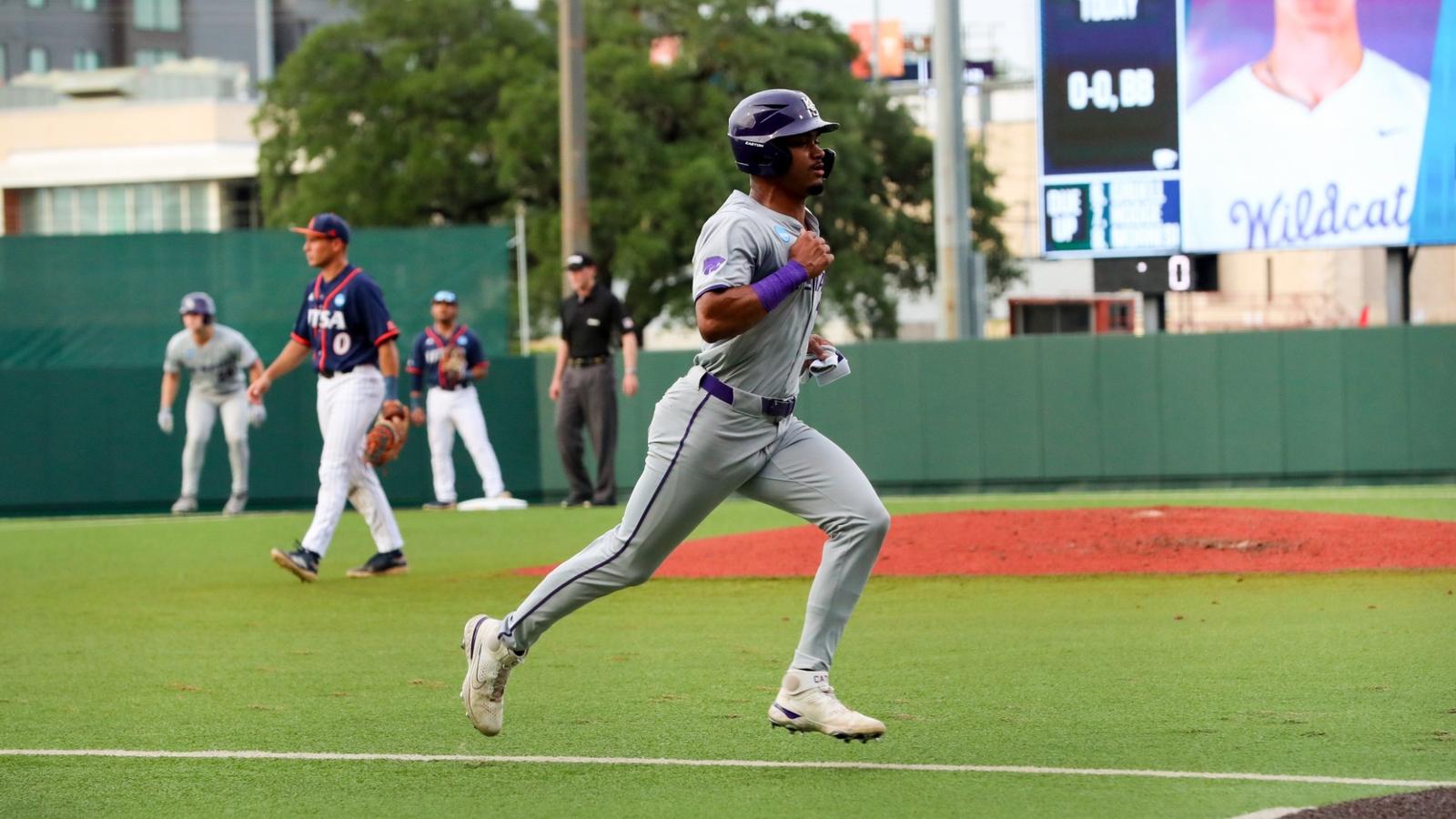
K-State fell to 31-25 on the year and will play an elimination game against No.4-seed Houston Christian (32-24) at 2 p.m. Saturday, followed by a matchup between UTSA (45-13) and No. 2 national seed and regional host Texas (43-12) at 8 p.m.
“UTSA put a lot of pressure on us and put the ball in play,” head coach Pete Hughes commented following the loss. “We had our opportunities, but bottom line is they got big two-out hits, and we didn’t.”
UTSA’s pitching staff of starter Zach Royse, and relievers Robert Orloski and Christian Okerholm limited the Wildcats to just two runs on six hits, with Royse (9-4) earning the victory. The right-hander surrendered one run and scattered just three hits in 5 1/3 innings with five strikeouts.
Offensively, four players for UTSA turned in multi-hit efforts with James Taussig generating a game-high three RBI with a three-run homer in the sixth.
“The three-run homer was the deciding point of the game, and then they damage controlled the fourth inning. [UTSA] did a great job there with the bases load and no outs and come out of there with only one run scoring. That’s pretty good job by them. [Royse] their starter battled and did a good job,” Hughes added.
Lefty Jacob Frost, who was tagged for the loss and moved to 1-5 on the year, held the Roadrunners to five hits in his 5 1/3-innings. The senior allowed five runs and struck out five in his 15th start, while issuing four walks.
Six different Wildcats produced a hit in the opening round, that included a solo blast by pinch-hitter Nick English, while AJ Evasco drove in a run with a sacrifice fly in the fourth.
Saturday’s elimination game will stream on ESPN+ and the ESPN app, while radio coverage is available on the K-State Sports Network with a free live streaming audio on kstatesports.com/watch.
HOW IT HAPPENED
After retiring the Cats in order, UTSA jumped on the board in the opening frame behind catcher Andrew Stucky’s single up the middle. UTSA’s Norris McClure homered to left field to expand the lead, 2-0, in the third inning.
Maximus Martin worked a walk, the third walk from Royse, to lead off the fourth before Seth Dardar laced the Cats’ first hit into center to position runners on first and third. Keegan O’Connor was hit in the next at bat to load the bases, forcing a mound visit for UTSA.
With one out, freshman AJ Evasco lifted a sacrifice fly to center, allowing Martin to score from third and pull the score within one.
The Roadrunners recovered the run handed over in the top of the inning, utilizing one hit and a fielding error to stretch their lead back out to two, but Frost’s fourth strikeout of the game left the bases loaded.
Shintaro Inoue beat the shift and lined his lone hit– a two-out single – between the Roadrunners’ second baseman and shortstop to register the Cats second hit of the game. Martin flared a 1-0 pitch into left field, but a diving catch by Garrett Gruell ended the threat.
Royse carried a two-hitter into the sixth, until O’Connor took a 2-2 pitch into right field, leading UTSA to make the first pitching change of the nightcap. Kennedy singled through the left side in his first at bat against reliever Orloski, until a wild pitch moved both runners into scoring position. The Roadrunners picked up two quick outs to strand the duo.
The Cats tacked a run to the board in the seventh, as Nick English stepped off the bench and blasted a solo shot 404-feet to left center.
UTSA spotted K-State for seven runs over a two-inning stretch to put the game away, highlighted by a three-run homer from James Taussig in the sixth.
INSIDE THE BOX
- UTSA scored 10 runs on 10 hits with no errors committed and left nine men on base.
- K-State scored two runs on six hits, committed two errors and stranded nine runners on base.
- Royse logged 5 1/3 innings of one-run, one hit ball with five strikeouts and three walks.
- Frost (1-4) was tagged for the loss, surrendering five runs, all earned, on five hits in 5 1/3 innings. The lefty issued four walks and struck out five.
- Six different players produced a hit for K-State.
- English homered in the seventh – his second of the year.
- Four Roadrunners turned in multi-hit efforts, led by three RBI from Taussig with his three-run homer in the sixth.
- UTSA drove in four runs with two outs, hitting .273 (3-for-11) with two away and .267 (4-for-15) in scoring position.
- K-State went 1-for-10 with two outs and was 0-for-6 with runners in scoring position.
TEAM NOTES
- UTSA pulled ahead, 3-2, in the all-time series between the two squads, while Friday marked the first meeting since 2009.
- K-State posts an all-time record of 9-7 during the regional round of the NCAA Tournament.
- The loss snapped a six-game winning streak in the regional round.
- K-State is 28-12 when hitting one or more home runs in a game.
2025 NCAA AUSTIN REGIONAL
Friday, May 30
1 p.m. CT – Game 1: No. 1 Texas 7, Houston Christian 1
6 p.m. CT – Game 2: No. 2 UTSA 10, K-State 2
Saturday, May 31
2 p.m. CT – Game 3: No. 4 Houston Christian vs. No. 3 K-State
8 p.m. CT – Game 4: No. 2/1 Texas vs. No. 2 UTSA
NIL
New agency to enforce legitimacy of NIL deals in college sports
For several years now, the world of NIL in college sports has essentially been the Wild West. Under the current system, every player is essentially a free agent after each season, and there is no salary cap for how much money schools can spend on players. However, that is reportedly about to change. With the […]
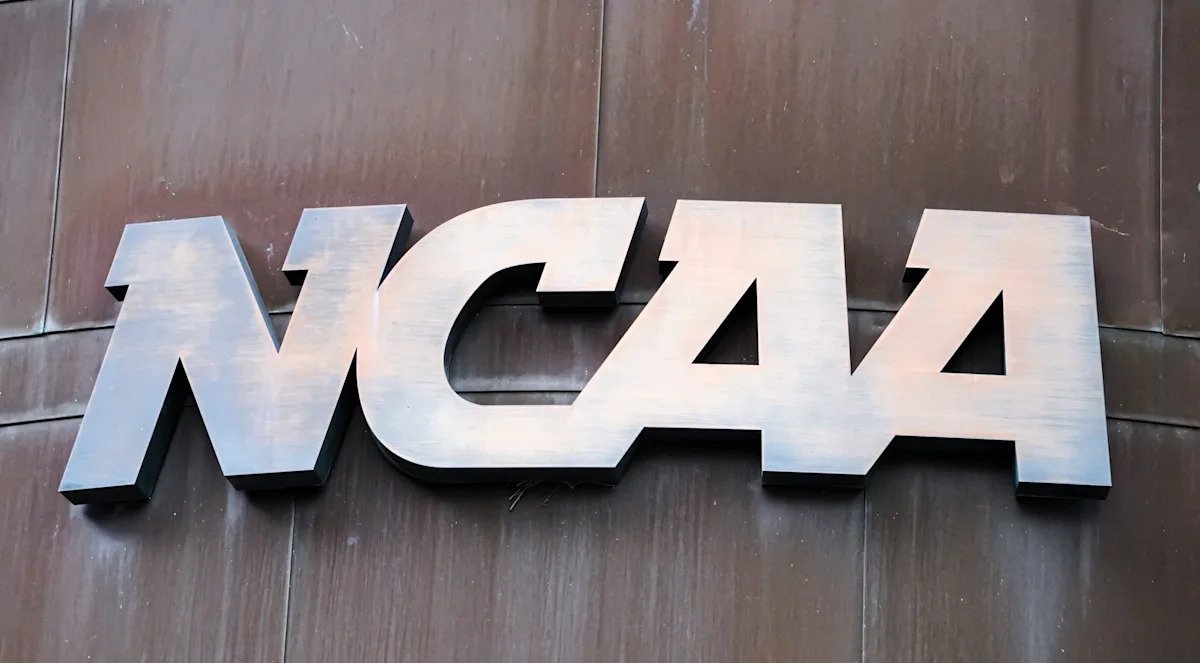
For several years now, the world of NIL in college sports has essentially been the Wild West. Under the current system, every player is essentially a free agent after each season, and there is no salary cap for how much money schools can spend on players.
However, that is reportedly about to change. With the dawn of the revenue sharing era, a new agency is reportedly going to enforce whether or not deals done outside of the revenue sharing system are legitimate endorsement contracts.
Advertisement
A report last week from Stewart Mandel of The Athletic detailed plans for the new enforcement agency.
“The recently approved House settlement, which took effect on July 1, established a clearinghouse, called NIL Go, that must approve all third-party deals for more than $600,” Mandel wrote. “The two main requirements for those deals are that they’re for a ‘valid business purpose’ and within a fair-market ‘range of compensation.’
“The goal is to prevent schools from utilizing booster-driven entities to funnel payments to recruits and transfers as a workaround to the $20.5 million revenue-sharing cap.
“Guidance issued Thursday by the College Sports Commission said that ‘an entity with a business purpose of providing payments or benefits to student-athletes or institutions, rather than providing goods or services to the general public for profit, does not satisfy the valid business purpose requirement set forth in NCAA Rule 22.1.3.’
Advertisement
“It then cited as an example a collective that ‘reach(es) a deal with a student-athlete to make an appearance on behalf of the collective at an event, even if that event is open to the general public, and the collective charges an admission fee (e.g., a golf tournament).’ And, ‘The same collective’s deal with a student-athlete to promote the collective’s sale of merchandise to the public would not satisfy the valid business purpose requirement for the same reason.’”
If the new system works as intended, programs will not be able to simply pay as much as they want for players. The goal is to put all schools on more of an equal playing field, rather than giving a massive advantage to the ones with the biggest collectives. It will be interesting to see if this effort is successful, or if schools continue to find new ways to get around the rules.
This article originally appeared on Trojans Wire: New college sports agency to enforce legitimacy of NIL deals
NIL
Argument over ‘valid buisiness purpose’ for NIL collectives threatens college sports settlement
Less than two weeks after terms of a multibillion-dollar college sports settlement went into effect, friction erupted over the definition of a “valid business purpose” that collectives making name, image likeness payments to players are supposed to have. The new College Sports Commission sent a letter to athletic directors last week saying it was rejecting […]

Less than two weeks after terms of a multibillion-dollar college sports settlement went into effect, friction erupted over the definition of a “valid business purpose” that collectives making name, image likeness payments to players are supposed to have.
The new College Sports Commission sent a letter to athletic directors last week saying it was rejecting deals in which players were receiving money from collectives that were created solely to pay them and don’t provide goods or services to the general public for profit.
A lead attorney for the players responded by saying those instructions went against settlement terms and asking the CSC to rescind the guidance.
“This process is undermined when the CSC goes off the reservation and issues directions to the schools that are not consistent with the Settlement Agreement terms,” attorney Jeffrey Kessler wrote to NCAA outside counsel Rakesh Kilaru in a letter obtained by The Associated Press.
Yahoo Sports first reported details of the letter, in which Kessler threatens to take the issue to a judge assigned with resolving disputes involved in the settlement.
Kessler told AP his firm was not commenting on the contents of the letter, and Kilaru did not immediately respond to AP’s request for a comment.
Yahoo quoted a CSC spokesman as saying the parties are working to resolve differences and that “the guidance issued by the College Sports Commission … is entirely consistent with the House settlement and the rules that have been agreed upon with class counsel.”
When NIL payments became allowed in 2021, boosters formed so-called “collectives” that were closely tied to universities to work out contracts with the players, who still weren’t allowed to be paid directly by the schools.
Terms of the House settlement allow schools to make the payments now, but keep the idea of outside payments from collectives, which have to be approved by the CSC if they are worth $600 or more.
The CSC, in its letter last week, explained that if a collective reaches a deal, for instance, for an athlete to appear on behalf of the collective, which charges an admission fee, that collective does not have a “valid business purpose” because the purpose of the event is to raise money to pay athletes, not to provide goods or services available to the general public for profit.
Another example of a disallowed deal was one an athlete makes to sell merchandise to raise money to pay that player because, the CSC guidance said, the purpose of “selling merchandise is to raise money to pay that student-athlete and potentially other student-athletes at a particular school or schools, which is not a valid business purpose.”
Kessler’s letter notes that the “valid business purpose” rule was designed to ensure athletes were not simply being paid to play, and did not prohibit NIL collectives from paying athletes for the type of deals described above.
To prevent those payments “would be to create a new prohibition on payments by a NIL collective that is not provided for or contemplated by the Settlement Agreement, causing injury to the class members who should be free to receive those payments,” Kessler wrote.
___
AP college sports: https://apnews.com/hub/college-sports
Copyright 2025 The Associated Press. All rights reserved. This material may not be published, broadcast, rewritten or redistributed without permission.
NIL
Why Vanderbilt football coach Clark Lea said he’ll handle revenue sharing better than NIL
ATLANTA – Just a few years after NIL and instant eligibility for transfers upended the college football world, programs must adjust again. The recent House settlement implemented revenue sharing, where schools pay players directly rather than them signing contracts with a collective. There’s a cap on how much revenue sharing money schools can give out, […]
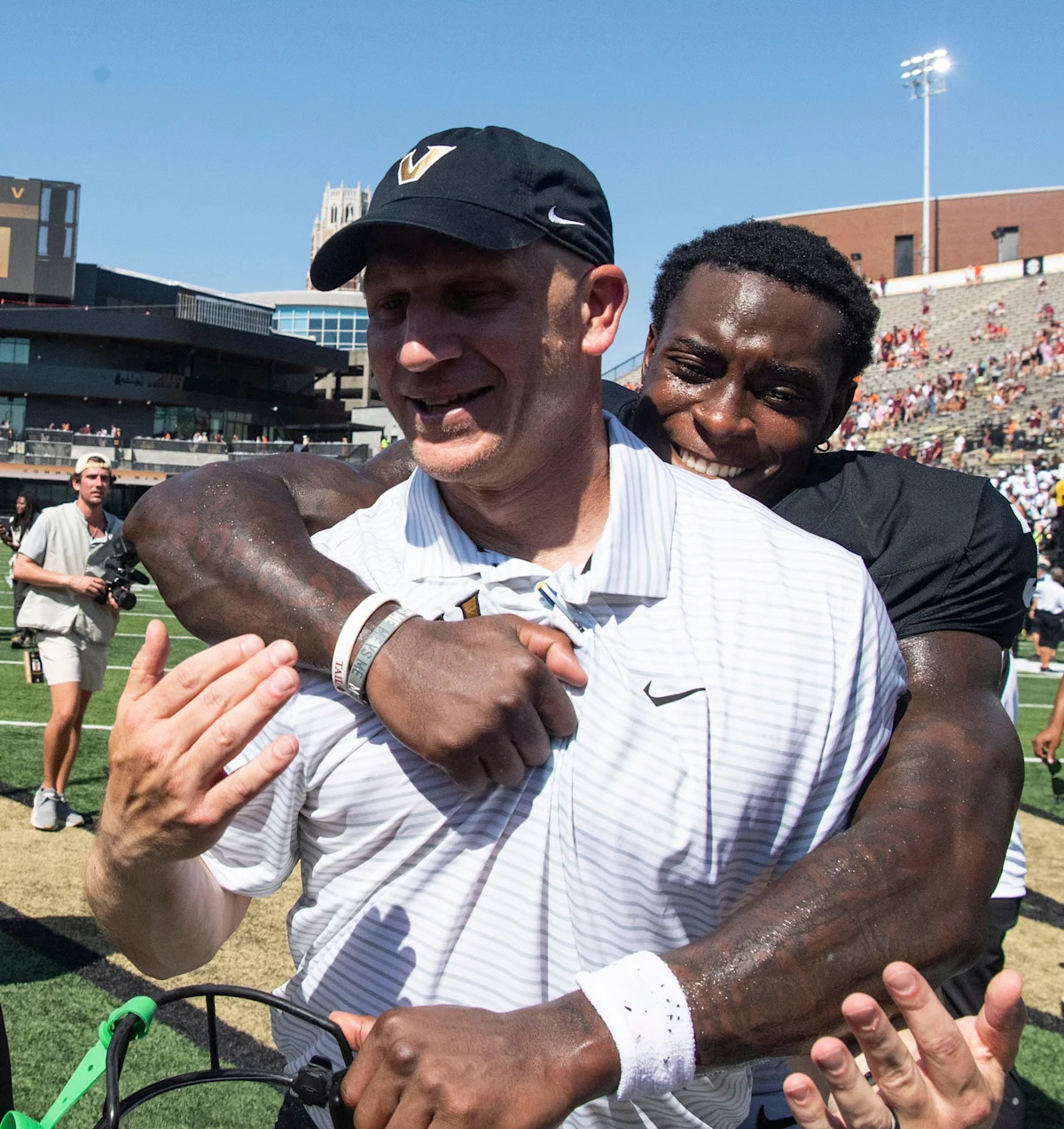
ATLANTA – Just a few years after NIL and instant eligibility for transfers upended the college football world, programs must adjust again.
The recent House settlement implemented revenue sharing, where schools pay players directly rather than them signing contracts with a collective. There’s a cap on how much revenue sharing money schools can give out, split across all sports. NIL deals can still exist, but they must go through a clearinghouse run by Deloitte called NIL Go.
Advertisement
On top of that, football teams can give out scholarships to anyone on their roster, but rosters will be capped at 105. Some players, called Designated Student Athletes, can be grandfathered in during the first few years of the roster limits if they were previously on the team.
Vanderbilt football coach Clark Lea was slow to adapt to the original NIL and transfer rules, but he believes he’s better prepared this time around. If anything, he said, the new rules make roster-building more straightforward.
“I don’t want to say it’s a seamless transition, because it’s a transition,” Lea said in a session with local media at SEC media days on July 14. “We’re going from contracts written through a collective to now having those as part of the revenue share salary cap. And so we have to transition to those contracts in a way that keeps up moving without skipping a beat.
” … There is no room for a team in our league that’s not fully participating. From there, it becomes, how do we engage the Nashville community to go beyond the revenue share? And I’m excited to explore all those things to better position us for where the game is headed.”
Advertisement
To engage the Nashville community, Lea said he saw opportunities for partnerships with local businesses that could sign Vanderbilt players to NIL deals above the revenue-sharing cap. Lea said he was not directly involved with those conversations, as he was better off focusing on football, but that other parts of the department were focused on taking advantage of those opportunities.
The Commodores have a higher profile going into 2025 than they’ve had in a while with returning quarterback Diego Pavia and tight end Eli Stowers, plus several other good players. Martel Hight could play offense, defense and special teams.
Storylines Five storylines for Vanderbilt football at SEC media days include Diego Pavia, revenue sharing
But there are still questions abounding. NIL Go has rejected several NIL deals, leaving teams uncertain about the level of enforcement that will take place.
Advertisement
Lea and Vanderbilt, like everyone else, will have to figure out those things as they go.
Aria Gerson covers Vanderbilt athletics for The Tennessean. Contact her at agerson@gannett.com or on X @aria_gerson.
This article originally appeared on Nashville Tennessean: Clark Lea: Vanderbilt football coach on revenue sharing vs NIL
NIL
OU twins drafted to MLB aim to do something baseball hasn’t seen in decades
As usual, Kyson Witherspoon was first, but eventually, like always, his twin brother Malachi followed. Kyson, who was born just minutes before Malachi, was taken 15th overall by the Boston Red Sox during the 2025 MLB Draft on Sunday. Then, in the second round, Malachi went to the Detroit Tigers with the No. 62 pick. […]

As usual, Kyson Witherspoon was first, but eventually, like always, his twin brother Malachi followed.
Kyson, who was born just minutes before Malachi, was taken 15th overall by the Boston Red Sox during the 2025 MLB Draft on Sunday. Then, in the second round, Malachi went to the Detroit Tigers with the No. 62 pick.
The twins made up two-thirds of the Oklahoma Sooners’ weekend starting rotation this past college baseball season and now have a chance to accomplish something that hasn’t been done since another pair of Sooners. Kyson and Malachi could become the first set of twins to make the MLB after being drafted the same year since 1996, according to MLB.com. The last duo to do it was Ryan and Damon Minor, also from OU.
Malachi and Kyson Witherspoon taken same day in MLB Draft
Kyson and Malachi have taken the same route to this point. They both went to Northwest Florida State College out of Fletcher High School in Neptune Beach, Florida. Both were MLB Draft prospects even in high school, but at that point, Malachi was actually ranked above Kyson.
In 2024, the duo transferred to OU, where Kyson eventually took over as the Sooners’ right-handed ace and emerged as one of the best pitchers in college baseball.
At the end of this past season, Kyson was named a First-Team All-American by Baseball America, D1Baseball, NCBWA and Perfect Game, and was a Second-Team All-American by ABCA. He was also a semifinalist for the Golden Spikes Award, which goes to the best player in college baseball.
Kyson was second in the SEC and No. 22 in the country with a 2.65 ERA in OU’s first season in a new conference. His 124 strikeouts ranked sixth in the country and fifth in the SEC. He tallied a team-high 10 wins with a 10-4 record, which was third-most in the SEC and 11th in the nation. He topped the SEC with a 5.39 strikeout-to-walk ratio.
Malachi, meanwhile, had a 5.09 ERA and 4-8 record as a weekend starter. He was projected to go between the third and fifth rounds before the Tigers jumped on him early in the second.
With Kyson and Malachi getting drafted, OU coach Skip Johnson has now had 29 pitchers taken in the MLB Draft since taking over the Sooners in 2018. Kyson was the fourth first-round pick under Johnson in eight seasons.
Read more about OU baseball
NIL
Argument over ‘valid buisiness purpose’ for NIL collectives threatens college sports settlement
Less than two weeks after terms of a multibillion-dollar college sports settlement went into effect, friction erupted over the definition of a “valid business purpose” that collectives making name, image likeness payments to players are supposed to have. The new College Sports Commission sent a letter to athletic directors last week saying it was rejecting […]
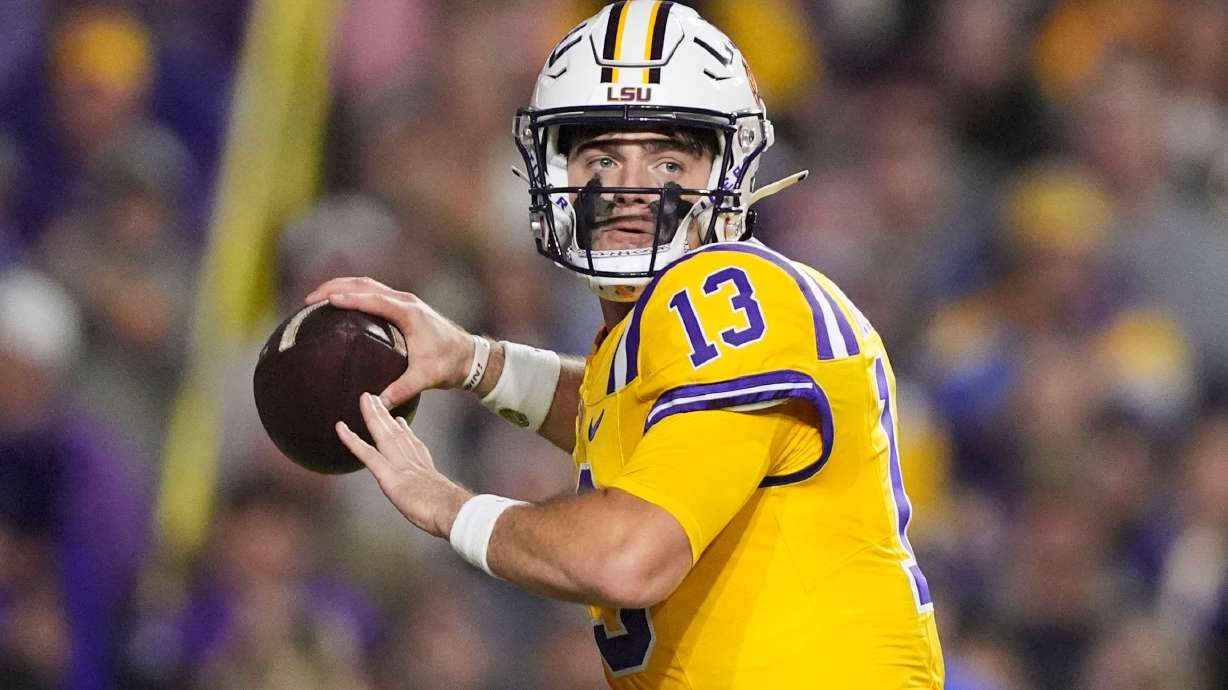
Less than two weeks after terms of a multibillion-dollar college sports settlement went into effect, friction erupted over the definition of a “valid business purpose” that collectives making name, image likeness payments to players are supposed to have.
The new College Sports Commission sent a letter to athletic directors last week saying it was rejecting deals in which players were receiving money from collectives that were created solely to pay them and don’t provide goods or services to the general public for profit.
A lead attorney for the players responded by saying those instructions went against settlement terms and asking the CSC to rescind the guidance.
“This process is undermined when the CSC goes off the reservation and issues directions to the schools that are not consistent with the Settlement Agreement terms,” attorney Jeffrey Kessler wrote to NCAA outside counsel Rakesh Kilaru in a letter obtained by The Associated Press.
Yahoo Sports first reported details of the letter, in which Kessler threatens to take the issue to a judge assigned with resolving disputes involved in the settlement.
Kessler told AP his firm was not commenting on the contents of the letter, and Kilaru did not immediately respond to AP’s request for a comment.
Yahoo quoted a CSC spokesman as saying the parties are working to resolve differences and that “the guidance issued by the College Sports Commission … is entirely consistent with the House settlement and the rules that have been agreed upon with class counsel.”
When NIL payments became allowed in 2021, boosters formed so-called “collectives” that were closely tied to universities to work out contracts with the players, who still weren’t allowed to be paid directly by the schools.
Terms of the House settlement allow schools to make the payments now, but keep the idea of outside payments from collectives, which have to be approved by the CSC if they are worth $600 or more.
The CSC, in its letter last week, explained that if a collective reaches a deal, for instance, for an athlete to appear on behalf of the collective, which charges an admission fee, that collective does not have a “valid business purpose” because the purpose of the event is to raise money to pay athletes, not to provide goods or services available to the general public for profit.
Another example of a disallowed deal was one an athlete makes to sell merchandise to raise money to pay that player because, the CSC guidance said, the purpose of “selling merchandise is to raise money to pay that student-athlete and potentially other student-athletes at a particular school or schools, which is not a valid business purpose.”
Kessler’s letter notes that the “valid business purpose” rule was designed to ensure athletes were not simply being paid to play, and did not prohibit NIL collectives from paying athletes for the type of deals described above.
To prevent those payments “would be to create a new prohibition on payments by a NIL collective that is not provided for or contemplated by the Settlement Agreement, causing injury to the class members who should be free to receive those payments,” Kessler wrote.
___
AP college sports: https://apnews.com/hub/college-sports
NIL
Wisconsin men’s basketball promotes Marc VandeWettering to general manager
Wisconsin Badgers General Manager Marc VandeWettering stands outside the Kohl Center. (Photo credit: UW Athletics) The Wisconsin men’s basketball program is officially stepping into the modern era and doing it with one of its most trusted staffers at the helm. In a press release, the Badgers announced that longtime staffer Marc VandeWettering has officially been […]
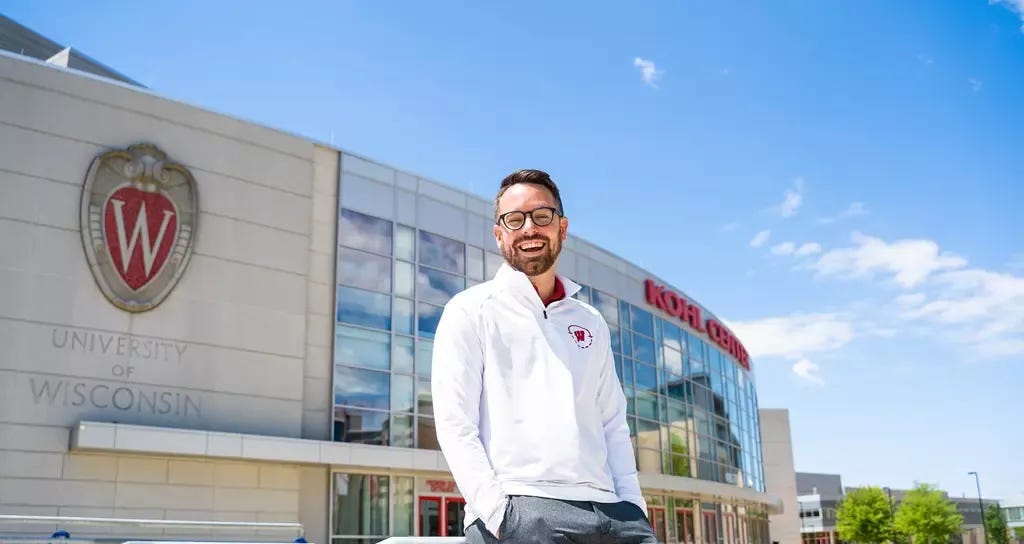

The Wisconsin men’s basketball program is officially stepping into the modern era and doing it with one of its most trusted staffers at the helm.
In a press release, the Badgers announced that longtime staffer Marc VandeWettering has officially been promoted to general manager. This formally establishes VandeWettering in a role that, if we’re being honest, he’s been preparing for and serving in for quite some time.
It’s not just a title change for VandeWettering. It’s Wisconsin signaling that they understand the realities of the college basketball landscape — a landscape shaped by the transfer portal, NIL collectives, player agents, roster management, and nonstop recruiting battles that leave little to no room for programs stuck operating in the past.
In this new position, VandeWettering will work directly alongside head coach Greg Gard to oversee recruiting strategy, player personnel, roster construction, and NIL revenue-sharing efforts, all while continuing to handle non-conference scheduling.
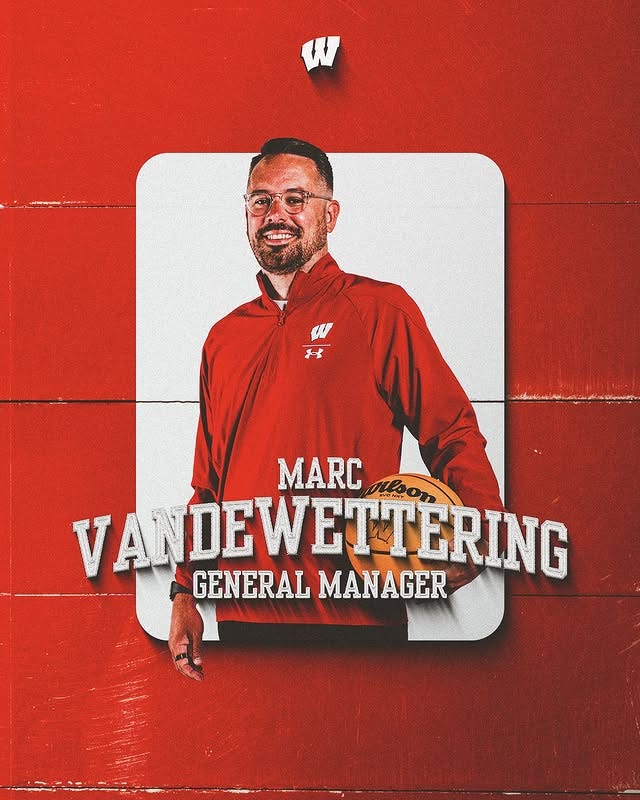
“I’m extremely happy for Marc and our program,” Gard said. “He has worked tirelessly to make us better every day and has helped us navigate this new era of college basketball very successfully. Marc has been a central figure in our evolution as a program and has already been handling many of the personnel tasks for the last couple of years. Looking to the future, I’m excited to have Marc officially elevated to this administrative role and know that he will help drive our sustained success.”
And if you’re wondering just how big of a deal this is, let’s break it down.
College basketball today doesn’t look anything like it did even five years ago. The introduction of NIL has flipped the power dynamics, with players now able to monetize their name, image, and likeness, and schools scrambling to build infrastructure around collectives and brand-new revenue-sharing models. Add in the transfer portal, where hundreds of athletes jump programs every offseason, and you’re looking at roster movement that rivals professional sports but without any guardrails.
In the NBA or NFL, you have a full front office: general managers, scouts, cap experts, analysts, and agents. In college? Those responsibilities often fall on the shoulders of a small coaching staff already tasked with running practices, preparing game plans, and developing players.
That’s where roles like VandeWettering’s come in.
What makes this move especially smart is that Wisconsin isn’t just reacting to the chaos of the new system; they’ve been proactively creating structure. They’ve given Gard someone he trusts implicitly to handle the nitty-gritty: conversations with player families, managing NIL expectations, evaluating portal fits, finding roster balance, and working through the agent-like representatives now involved at the college level.
For VandeWettering, it’s the culmination of more than a decade inside the Badgers basketball program.
A native of Kaukauna, Wisconsin, VandeWettering began his journey as a student manager and was the head manager during Wisconsin’s 2013–14 Final Four season under head coach Bo Ryan. After gaining additional experience as the assistant director of basketball and football operations at the Big Ten office, where he helped run championship events across multiple sports, VandeWettering returned home to Wisconsin in 2017 as the program’s director of operations.
By 2023, VandeWettering was serving as the Badgers’ chief of staff, quietly shaping the team’s day-to-day functions and already playing a key role in personnel matters. This promotion just makes it official.
“I’m incredibly grateful for the opportunity to support Coach Gard, our staff, and our student-athletes in this role,” VandeWettering said in the press release. “Wisconsin Men’s Basketball is built on a foundation of consistency, accountability, and a team-first approach — and I’m committed to helping us build on that legacy. Our focus is on sustaining the high standards of this program while continuing to evolve and position ourselves for long-term success in a changing landscape.”
And let’s be clear: this “changing landscape” isn’t just coachspeak.
Every major college basketball program now has to navigate the delicate balance between retaining homegrown talent and bringing in outside help through the portal to compete. It’s a win-now era. They need someone monitoring NIL deals to ensure players feel valued without fracturing the locker room. They need someone to network with collectives and administrators to keep the financial machine running. They need someone to scout the portal and high school ranks during the season to identify gaps, not just for the next season, but for multiple seasons down the line.
VandeWettering is that someone for Wisconsin.
This offseason alone has shown just how critical these roles are. The Badgers had to reload their roster after a myriad of notable departures with hand-picked portal additions that fit the system and culture, all within the basketball program’s financial constraints.
But beyond the transactions, this move reflects the broader plan that Gard set in motion a while back.
Gard has effectively reshaped Wisconsin’s basketball infrastructure, adding dedicated roles like Kirk Penney as offensive coordinator, Lance Randall for his range of coaching experience, and Greg Stiemsma for player development. Bringing on Isaac Wodajo as director of recruiting and scouting further shows how intentional Gard has been about elevating the program into a modern operation — without losing the cultural foundation that’s defined Badgers basketball for decades.
VandeWettering, in many ways, is the glue guy behind it all.
Gard has no intention of stepping back from the action, that much he’s made clear. That said, having a general manager-level figure in the front office gives him the ability to stay plugged in without drowning in an administrative overload. It allows the staff to be more nimble, more aggressive, and, importantly, more prepared as things keep shifting.
In the arms race of modern college hoops, you either adapt or you get left behind.
“I want to be able to control—or at least have a say—on who’s coming in and who’s going out of our program,” Gard said. “I give a lot of responsibility and voice to my staff.”
With VandeWettering now officially steering the ship on the front office side of things, Wisconsin isn’t just keeping pace — they’re setting themselves up to succeed for the long haul, with someone who understands the pillars this program was built on. And for a program built on consistency, accountability, and development, that’s exactly the kind of evolution that can keep the Badgers competitive for years to come.
This promotion may be behind the scenes, but its impact will be felt in every corner of the Wisconsin men’s program.
We appreciate you taking the time to read our work at BadgerNotes.com. Your support means the world to us and has helped us become a leading independent source for Wisconsin Badgers coverage.
You can also follow Site Publisher Dillon Graff at @DillonGraff on X.
-

 Technology3 weeks ago
Technology3 weeks agoPet fitness and wellness trends for a healthier and happier dog
-

 College Sports3 weeks ago
College Sports3 weeks agoWAC to Rebrand to UAC, Add Five New Members in 2026
-

 Motorsports2 weeks ago
Motorsports2 weeks agoWhy Cosmetics are Making Up for Lost Time in Women’s Sports
-

 College Sports3 weeks ago
College Sports3 weeks agoA new era of Dickinson hockey begins behind the bench – The Dickinson Press
-

 Health3 weeks ago
Health3 weeks agoFlorida assault survivor shares hope for change with new mental health law
-

 Motorsports1 week ago
Motorsports1 week agoTeam Penske names new leadership
-

 Motorsports3 weeks ago
Motorsports3 weeks agoNASCAR This Week – Patriot Publishing LLC
-

 Sports3 weeks ago
Sports3 weeks agoHow to Market FAST Sports Content to New Audiences
-

 Youtube2 weeks ago
Youtube2 weeks agoBREAKING: NBA MVP Shai Gilgeous-Alexander signs the RICHEST annual salary in league history
-

 Sports6 days ago
Sports6 days agoNew 'Bosch' spin

































